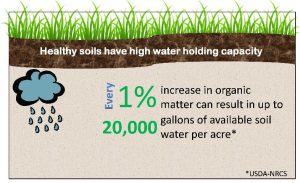Introduction:
In the soil science world, soil health is a term synonymous with soil quality. The health or quality of a soil is often related to its soil organic matter (SOM) content. Soil organic matter is made up of plant residue, animal tissue, and animal waste at various stages of decomposition. This material feeds and supports a diverse/abundant population of soil microorganisms. One teaspoon of healthy soil is said to contain more microorganisms than there are people on earth! Soil organic matter has multiple biological, chemical, and physical characteristics that are beneficial for supporting plant growth.
Biological Benefits of SOM:
Supporting a diverse and abundant population of microorganisms can be beneficial for suppressing certain pests. Many microorganisms also form symbiotic mutualistic relationships with plants. For example, mycorrhizal fungi colonize the soil around plant roots increasing the surface area where roots can access nutrients and water. In return, plants provide mycorrhizal fungi sugar compounds formed through photosynthesis.
Chemical Benefits of SOM:
Since SOM is primarily derived from plant tissue, it is a source of essential plant nutrients needed for plant growth. Organic matter also increases a soil’s cation exchange capacity which refers to its ability to retain positively charged ions known as cations. Increasing cation exchange capacity is beneficial for retaining calcium, magnesium, and potassium.
Physical benefits of SOM:
One of the physical benefits of SOM is that it acts like a sponge, increasing a soils capacity to absorb and retain water. Every 1% increase in SOM can increase a soil’s ability to retain water up to 20,000 gallons per acre. Increasing SOM is also helpful in reducing soil compaction allowing plant roots to access available water and nutrients.

Increasing Soil Health in North Florida:
North Florida soils generally contain low SOM around 1%. The low SOM is a result of the warm climate and our sandy soils. In cooler climates, the microbes that feed on SOM decrease their activity at cooler temperatures. Sandy soils also tend to contain lower SOM in comparison to finer textured soils (made up of predominately small mineral particles) such as silt or clay. There are practices growers can take to increase SOM on their farms. Reducing soil disturbance, such as tillage can increase SOM overtime. Tillage can be helpful for seedbed preparation, controlling weeds, and incorporating fertilizer/organic soil amendments. However, frequent tillage will reduce soil quality and SOM by aerating and breaking apart soil particles. Utilizing cover crops and leaving crop residues are also beneficial for increasing SOM. Cover crops may provide rotation between plant families which is beneficial for suppressing plant disease and pests. Cover crops in the legume family can be used to fix atmospheric nitrogen making it available for the subsequent cash crop. Incorporating organic amendments such as compost, manure, biochar, and potting soil can help to increase SOM. It takes time, often several years, to see a measurable increase in SOM when managing large plots of land. When utilized long-term, these practices can help provide plants nutrients, diverse/abundant populations of soil microorganisms, water, and uncompacted space to grow roots.
For more information see UF/IFAS extension articles below:
Tools for Evaluating Soil Health:
https://edis.ifas.ufl.edu/ss657
Raising Soil Organic Matter Content to Improve Water Holding Capacity:
https://edis.ifas.ufl.edu/ss661
Featured image courtesy of Julio Pachon (PhD candidate – UF/IFAS Soil and Water Sciences Department).
 0
0
